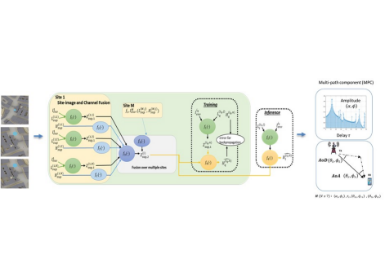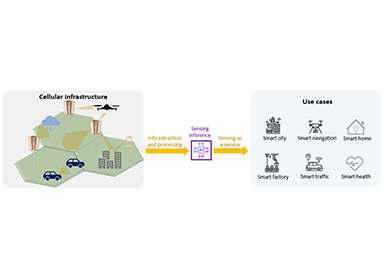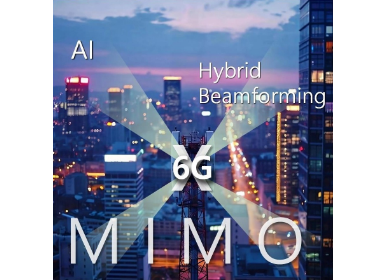Communications
User Traffic based Adaptive Beam Codebook Management for mmWave Communication
Background
Recently, the beam codebook based analog beamforming [1]–[4] is adopted in mm-Wave communication for the trade-off between complexity and performance, where the beam codebook is a matrix composed of a large number of beam weight vectors. However, how to manage the beam codebook is a challenge. The current beam codebook is fixed after configuration. When the UE(the total users under a certain beam) traffic changes, the beams with high traffic need more resources than the beams with low traffic. In this case, the low traffic beams underutilize the allocated resources while the high traffic beams are short of resources. Thus a user traffic based adaptive beam codebook management algorithm is proposed in this paper which takes the UE traffic into account to manage beams. In the proposed beam codebook, low traffic beams are merged and the high traffic beams are split. Then the transmission time slots saved by merging beams can be transferred to the divided beams enabling the UEs to reuse the frequency resources with higher beam gain. Thus, the system throughput can be improved.
Adaptive Beam Codebook Management Algorithm
As shown in Figure.1, the proposed algorithm configures the beam codebook which will be used for transmission in the next period according to the predicted UE traffic. The UE traffic is predicted by an artificial intelligence (AI) model according to the UE traffic in the current beams [5]. Then the low traffic beams are merged while the high traffic beams are divided into narrower beams with higher beam gain. Thus the transmission time slots saved by merging beams can be transferred to the divided beams enabling the users to reuse frequency resources. The ratio of the sum rate and the predicted throughput in a beam is used to determine whether to merge or split beams.

Figure 1. The process of merging and dividing beams
Experimental Results
Simulation results are provided to compare the achieved throughput of the fixed beam codebook and the proposed adaptive codebook. The simulation scene is modeled as a cell with a radius of 100 meters and a 100m×100m rectangular area is located in the cell which is similar to the typical high user density environment of mm-Wave system. The signal is transmitted with 100MHz system bandwidth at the 39GHz carrier frequency as standard assumption, and the simulation channel model is the UMi. For the resource scheduler, the well known proportional fair (PF) criteria is used for allocating resource to UEs. As a typical assumption of mmWave system, the number of antenna elements at BS antenna array is 2048 and they are deployed in 4 antenna panel with 16 horizontal elements and 32 vertical elements in each panel. We only focus on the azimuth angle of beam pattern. The total number of beams generated by the BS antenna array is 64. The number of antenna elements at UE is 32 and it only generates one flat and wide received beam.
Two traffic distribution scenarios are modeled. In the first scenario, the UEs are randomly and uniformly dropped in the whole cell and the number of the UEs is 200. In the second scenario, 80% of the UEs are randomly and uniformly dropped in the hotspot and the rest 20% of the UEs are dropped outside of the hotspot. The traffic is modeled as a data package which is the same for all UEs.

Table 1. Simulation parameters
The cumulative distribution function curve of the achieved UE throughput in the fixed beam codebook and the adaptive beam codebook are provided in Figure. 2 and Figure. 3.
In the Figure. 2, the corresponding two curves are close to each other. This is because all the UEs are randomly and evenly dropped in the whole cell, which means the traffic is evenly distributed in the beams. In this case, the gap between the sum rate and the traffic in the fixed beam codebook is small. While in the Figure. 3, 80% of the UEs are dropped in the hotspot and the traffic in the beams covering the hotspot is much higher than the sum rate supported by those beams. By improving the sum rate of the beams covering the hotspot, more UE traffic can be transmitted. As is shown in the Figure. 3, the throughputs of 90% of the users are improved, the maximum throughput improvement can be observed from curves that the proposed algorithm is increased by 23%.

Figure 2. UE throughput in scenario 1.

Figure 3. UE throughput in scenario 2.
Link to the paper
https://ieeexplore.ieee.org/document/10013057/References
[1] Junyi Wang et al., "Beam codebook based beamforming protocol for multi-Gbps millimeter-wave WPAN systems," in IEEE Journal on Selected Areas in Communications, vol. 27, no. 8, pp. 1390-1399, October 2009, doi: 10.1109/JSAC.2009.091009.
[2] H. Ju, Y. Long, X. Fang and R. He, " Systematic Beam Management in mmWave Network: Tradeoff Among User Mobility, Link Outage, and Interference Control," 2020 IEEE 91st Vehicular Technology Conference (VTC2020-Spring), 2020, pp. 1-5, doi: 10.1109/VTC2020-Spring48590.2020.9129387.
[3] H. Shokri-Ghadikolaei, L. Gkatzikis and C. Fischione, "Beam-searching and transmission scheduling in millimeter wave communications," 2015 IEEE International Conference on Communications (ICC), 2015, pp.1292-1297, doi: 10.1109/ICC.2015.7248501.
[4] T. Oh, C. Song, J. Jung, M. Ahn, J. Kim and I. Lee, "A New RF Beam Training Method and Asymptotic Performance Analysis for Multi-User Millimeter Wave Systems," in IEEE Access, vol. 6, pp. 48125-48135, 2018, doi: 10.1109/ACCESS.2018.2867905.
[5] C. Zhang, H. Zhang, J. Qiao, D. Yuan and M. Zhang, "Deep Transfer Learning for Intelligent Cellular Traffic Prediction Based on Cross-Domain Big Data," in IEEE Journal on Selected Areas in Communications, vol. 37, no. 6, pp. 1389-1401, June 2019, doi:10.1109/JSAC.2019.2904363.






